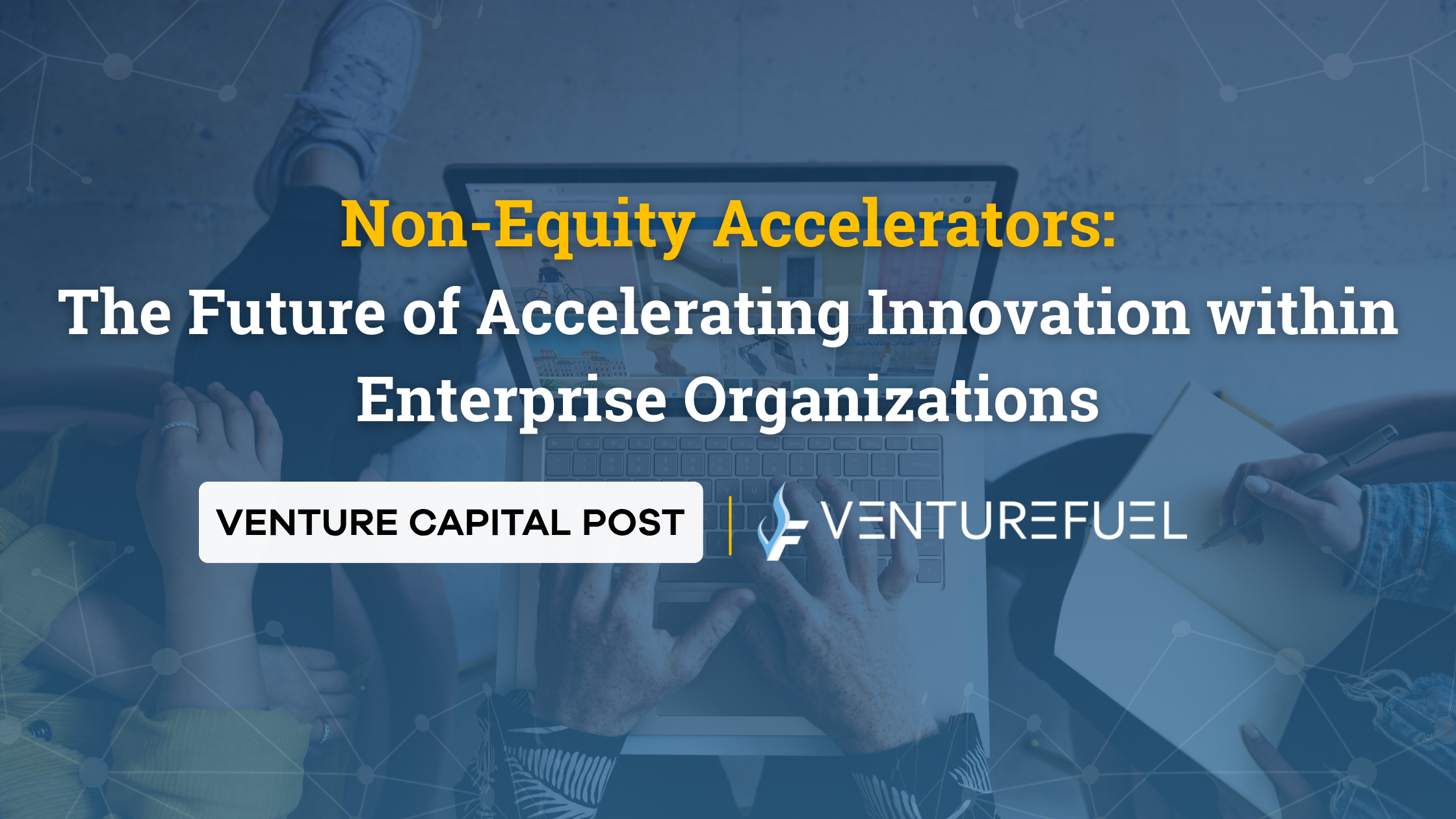
Non-Equity Accelerators: The Future of Accelerating Innovation within Enterprise Organizations
Enterprise organizations are routinely seeking new ways to drive transformation. Recently, market conditions have created a disproportionate advantage for corporates to pursue this transformation by partnering with startups for mutual benefits. The VC ecosystem is more risk-averse, demanding validation of startups' business models via product-market fit, profitability, and commercialization. Founders are being forced to demonstrate that customers will pay for their product or service prior to securing investments. Meanwhile, many large enterprise organizations have strong cash positions but are struggling to keep up with the accelerated pace of change and see startup collaborations as a cost-effective augmentation to traditional R&D. The volatility of this ever-changing risk-averse world has created the perfect environment for these seemingly disparate parties to work together to drive mutual growth.
Traditionally, the way corporates and startups collaborate has primarily been through corporate accelerators. The appeal of this approach is reflected in the growth of corporate accelerators from a select few in 2010 to hundreds today. The results speak for themselves: startups that graduate from accelerator programs have a 23 percent higher survival rate when compared to unenrolled startups, and outsourced innovations can be commercialized by corporations at 40 percent faster than innovations produced internally.
As fast as accelerators have proliferated, many have been maligned as startup petting zoos masquerading as innovation and others as pure money-grabs that take huge equity stakes for little true value. Corporates also tend to shut down their accelerators quickly because the startups they attract are not enterprise-ready. The best accelerators have evolved to focus on providing true value to both corporations and startups. These collaborations drive tangible outcomes and benefits, such as access, exposure, and rapid commercial collaboration, for both parties. Now, many realize that the default accelerator model of seed-stage investment and junior-level mentoring is not what startups or corporates want. It is time to evolve the model.
The Non-equity Difference: A Shift in Accelerator Dynamics
In exchange for the resources they provide, corporations have typically taken a small equity stake (typically somewhere between 3 to 8 percent) in the startups that they accept into their accelerator programs. However, most corporations do not aim to become micro-investors or run early-stage investment funds. Rather, they are looking for strategic insights into what's next for their industry or business and to innovate faster to meet market and consumer demands with minimized risk. Equity isn't a driver for them, and, in fact, it creates unwanted headaches around governance, valuations, and management of a portfolio.
Oftentimes, startups do not want, or cannot meet, the terms of these traditional equity-based accelerators. The startups may be at different stages, have varying valuations, or may be hesitant to put an investor on their cap table, which can complicate subsequent rounds of fundraising. Startups want to work with corporates to access their network knowledge and foster relationships that could lead to opportunities for commercial partnerships, but many want to engage without offering equity or a stake.
Hence, many corporate accelerator programs have removed equity from the equation and have found greater quality startups without many of the mutual headaches both were needlessly enduring. These corporate accelerators can now re-focus on the symbiotic relationships where startups gain access to curated programming, resources, and support, and the corporates gain value in the insights and potential partnerships that result from the engagements.
For enterprises, non-equity accelerator programs can often deliver more concrete and immediate ROI to their business: a new supplier, a new customer, or a new knowledge source that can help them stay competitive and seize new growth opportunities. Plus, if investing is an important element of their strategy, non-equity accelerators can provide the opportunity for more strategic investment opportunities at the end of programs, after startups have proven their value and potential. This stage-gate investment strategy de-risks investments and better aligns the two parties' long-term aspirations.
Strategic Advantages in Non-equity Models
Take the example of Comcast NBC Universal's LIFT Labs, which connects startups with Comcast business leaders to promote collaboration. Having built one of the world's most celebrated traditional corporate innovation accelerator programs in 2018, Comcast's LIFT Labs transitioned to a non-equity model in 2023 to drive stronger value for the business and the startups with which they were engaging.
In this new non-equity model, LIFT Labs operated two cohorts over the course of the year, one focused on Generative AI and one on Enterprise AI, both of which were grounded in strategically relevant areas of exploration for their core business units. The participating startups for both cohorts ranged from idea-stage to Series B, a variance that would have been incredibly difficult to achieve in the previous equity-based model but one that resulted in significant value to the business. Via pilots and commercial deals with these startups, Comcast obtained tangible wins and strategic insights for the overarching business and created a validated pipeline of cutting-edge technologies for Comcast Ventures, the organization's corporate venture capital arm, should they wish to invest.
In a completely different industry, we can look to the example of the Real California Milk Excelerator, a product innovation accelerator with a non-equity model that has now accelerated over fifty startups in partnership with the California Milk Advisory Board (CMAB), an instrumentality of the California Department of Food and Agriculture focused on increasing demand for California's sustainable dairy products. By focusing on issuing non-dilutive grants versus equity-based investments, CMAB attracts various stages of startups that can benefit from the resources, mentorships, and introductions to retailers that truly accelerate the startups that inevitably scale innovative uses of California milk to reach new target consumers and demographics.
Embracing the Future
Make no mistake: corporates should be investing in startups, and corporate venture capital is a critical tool in future-proofing and driving growth. However, equity-based accelerators should not be the default choice for corporate-startup collaborations. The non-equity accelerator model offers corporates and startups a superior and more strategic deal. This approach prioritizes collaboration and knowledge sharing, supporting sustainable growth for startups and more effective integration of innovative solutions into corporate business strategies, all while fostering a mutually beneficial ecosystem of growth and innovation.
Although the decade-old traditional equity-based accelerator model helped these two disparate groups realize the benefits of corporate-startup collaboration, the model has now evolved to more effectively provide what startups and corporates actually want and need in today's market: symbiotic value. The non-equity accelerator model not only accelerates innovation but also enhances collaboration and reduces risk, enabling both parties to capitalize on emerging opportunities while fostering a dynamic and adaptable environment for collaborative growth.

